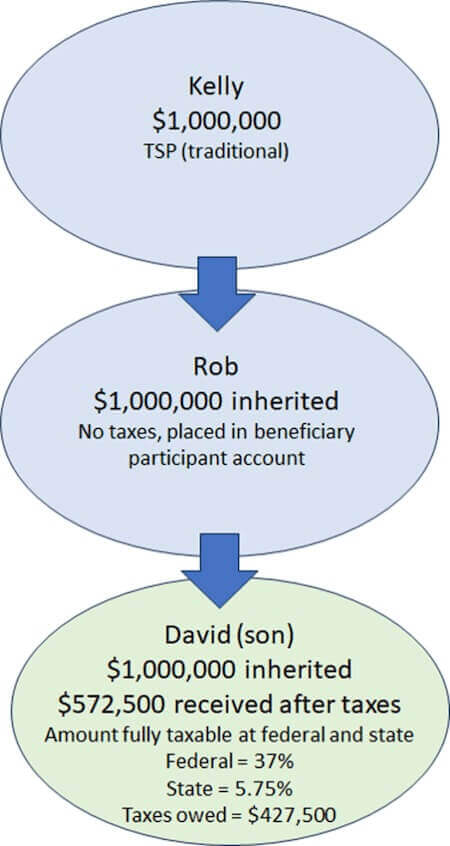The Thrift Savings Plan (TSP) is a critical component of federal employees’ retirement strategies, yet it’s shrouded in misconceptions and misunderstandings that can derail even the most meticulously laid financial plans. Dispelling these myths is the first step toward optimizing your retirement income and ensuring that you’re fully benefiting from your federal benefits under the Federal Employees Retirement System (FERS).
We will delve into the top 11 common misconceptions we see and equip you with the knowledge to make informed decisions about your retirement savings.
1. My income is too high to contribute to Roth TSP
There are no income limits for Roth TSP! We often hear that federal employees have not been contributing to Roth TSP because their income is too high. These income limits relate only to outside Roth IRAs. You can earn well above the income limits that are required for Roth IRAs and there will be no issue.
2. Contributing the max into the Roth TSP will result in losing the 5% government match. At least 5% must go to traditional TSP to receive the match.
You may contribute the max into Roth TSP and still receive the 5% TSP match. The government will not place your match into Roth. 100% of the government match goes into traditional TSP.
3. I’ll max out my TSP early in the year to allocate more funds to other areas for the remainder of the year.
Ensure you maximize your Thrift Savings Plan (TSP) contributions across all your pay periods in the year, typically 26. It’s crucial not to hit the maximum contribution limit too early, risking missing out on TSP matching funds.
Divide the maximum 2024 contribution limits of $23,000 or $30,500 by the number of pay periods you have. For instance, reaching the max by June 1st means forfeiting half of the year’s potential match (2%). Repeating this error throughout your federal career could result in significant financial loss, potentially totaling tens of thousands of dollars.
If you are on 26 pay periods:
- $884 per pay period for $23,000
- $1,173 per pay period for $30,500
4. The S fund is a small-cap fund
The TSP designates the S fund as a “Small Cap Stock Index Investment Fund,” which can be misleading. Its goal is to mirror the Dow Jones U.S. Completion Total Stock Market Index. This fund encompasses a mix of large, mid-sized, and small companies. Understanding the composition of the companies within the S fund is important for an effective investment strategy.
5. I will receive a 10% penalty for withdrawing before age 59 ½
This one depends. There are special exceptions that are only applicable to TSP retirees. If you meet one of the following you are exempt from the 10% penalty if withdrawing before age 59 1/2:
- Retirement in or after the year the account holder turns 55
- Public safety employees who retire in or after the year they turn 50
- Phased retirement
- Payments under certain qualified court orders (e.g., divorce, child support, etc.)
6. The TSP annuity option is owned by TSP
When opting for an annuity within your TSP, it’s vital to understand that TSP does not manage the annuity directly; it’s handled by an external provider. Presently, MetLife serves as the vendor for the annuity option. Your annuity will transition from TSP administration to MetLife. It’s important to note that selecting the single life annuity option will not leave the remaining balance in your TSP to your family or beneficiaries.
7. I am limited to one withdrawal every 30 days
Technically this is not true. You can receive an installment payment and a partial withdrawal. You may choose to receive installments from your account monthly, quarterly, or annually.
In addition, you can receive a distribution of all or part of your TSP account. There is no limit on the number of partial distributions you can take, but TSP will not process more than one in any 30-day period.
8. Matching the L fund with my retirement date takes care of my investment strategy
Just choose the L fund that corresponds with your retirement date and be done, right? The common set-it-and-forget-it strategy. While this statement may hold true during the initial stages of one’s career, the complexity of investment strategy changes upon retirement.
Maintaining funds in the L Income Fund would lead to holdings predominantly in the G Fund (69%) and the F Fund (5.60%), totaling nearly 75% of the portfolio invested in cash and bond equivalents as of January 2024. Relying solely on the L Income Fund to generate retirement income may run the risk of not keeping up with inflation and potentially running out of money too soon.
9. At retirement, I can select the fund from which I withdraw my investments
If you take a withdrawal, the money must come out pro-rata based on your investment allocation. You are unable to select one fund to withdraw the money from. Below is an example of a $10,000 withdrawal.
| Fund | Allocation | Amount |
|---|---|---|
| G Fund | 25% | $2,500 |
| F Fund | 25% | $2,500 |
| C Fund | 20% | $2,000 |
| S Fund | 15% | $1,500 |
| I Fund | 15% | $1,500 |
10. Misunderstanding of TSP loans
While the interest paid on a TSP loan is returned to you, two main downsides are often disregarded. Firstly, the loan amount doesn’t accrue growth based on your investment choices. Secondly, you face double taxation on the interest paid. When repaying interest into the TSP loan, you’re using after-tax funds, which are taxed again upon withdrawal at a later date.
11. My beneficiary will inherit TSP tax-deferred
True and false.
True = your primary beneficiary will receive TSP funds into a beneficiary participant account (tax-deferred)
False = beneficiary of a beneficiary participant will receive TSP funds into a beneficiary participant account (tax-deferred)
There are no issues if a spouse (or primary beneficiary) receives the TSP in the event you predecease him/her.
What happens when a beneficiary participant dies? The money cannot remain in the Thrift Savings Plan. The payments must be made directly to whom the beneficiary participant has chosen. The beneficiary of a beneficiary participant will be taxed at 100% of the account value at federal and state taxes. Consequently, the TSP funds cannot be rolled over into another beneficiary participant account to continue the deferral of taxes.
For example, say you predecease your spouse. Your spouse receives the TSP funds into a beneficiary participant account. When your spouse passes away, the funds go to your son or daughter. In this scenario, the full amount received will be taxable. The children will be unable to place these funds into a beneficiary participant account and could be taxed at the highest tax bracket.
The content is developed from sources believed to be providing accurate information. The information in this material is not intended as tax or legal advice. Please consult legal or tax professionals for specific information regarding your individual situation. The opinions expressed and material provided are for general information and should not be considered a solicitation for the purchase or sale of any security. Securities and advisory services offered through Osaic Wealth, Inc., member FINRA, SIPC. Osaic Wealth is separately owned and other entities and/or marketing names, products or services referenced here are independent of Osaic Wealth. Representatives may not be registered to provide securities and advisory services in all states. Branch address: 10701 Parkridge Blvd, Ste 130, Reston, VA 20191. Branch phone: 571-543-2783.






